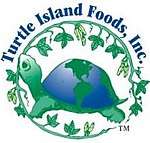Turtle Island Foods
 | |
| Industry | Food products |
|---|---|
| Founded | 1980 in Forest Grove, Oregon, United States |
| Founder | Seth Tibbott |
| Headquarters | Hood River, Oregon, United States |
Areas served | United States, Canada |
Key people | |
| Products | Meat analogue roasts (Tofurkey) tempeh |
| Revenue |
|
| Website |
tofurky |
Turtle Island Foods is an American company founded in 1980 in Forest Grove, Oregon and headquartered in Hood River, which produces Tofurky, a popular vegetarian and vegan alternative to turkey, as well other meatless products. All of the company's products are vegan, and most are kosher-certified by the Kosher Services of America.[3] Turtle Island Foods is also the first company in the United States to have their products approved by The Vegan Society in the United Kingdom.[4]
History
Headquartered in Hood River, Oregon, Turtle Island Foods began in 1980 in Forest Grove[5] with intentions "to create delicious, nutritious, convenient and affordable vegetarian food."[6] It was founded by Seth Tibbott,[7][8] who began by producing tempeh for friends and family.[7] Tibbot was inspired to create meat substitutes after having become a vegetarian in college.[2]
The company name is derived from a common legend found amongst the native people of North America.[9] Once, when all of earth was underwater, a turtle offered its shell as a home for land animals, and that shell became North America. As a result, several Native American and First Nations refer to the continent as "Turtle Island."
With the help of family, Tibbot eventually expanded his company to what is now the second largest tempeh producer in the United States. Turtle Island Foods has no parent company.[7] The famous Tofurky was only developed in 1995,[2] and initially sold in local markets in Portland, Oregon.[10] According to Tibbot, the first twenty years of the company had not been economically fruitful, and he built tree houses on a neighbor's property in Husum, Washington, which he rented out to tenants for additional income.[10] During the Thanksgiving season of 1995, the company sold a total of 500 of their Tofurky roasts.[10]
In the early 2000s, the company began to grow considerably, shipping a record-breaking 201,108 of their Tofurky roasts in 2006, a 27% increase from the year prior.[11] In 2008, Turtle Island became a sponsor of The Humane Society, the first food processor to do so in the society's history.[12]
In 2011, the company announced plans to build a new plant in Hood River at a cost of $10 million with a goal to achieve a LEED platinum certification on the building.[13][14] The new 33,000-square-foot (3,100 m2) plant opened in October 2012.[8]
Ecological responsibility
Since 1995, when Turtle Island Foods took an official stand against GMOs, they have made "every effort possible" to avoid them.[15] Much of what the company produces is organic, and Turtle Island Foods is actually an "Organic Processor", certified as Oregon Tilth Certified Organic.[16] According to the Cornucopia Institute, Turtle Island uses tofu sourced from 100% organically-farmed soybeans, and all manufacturing of products is done in the company's facility.[17]
The company refuses food ingredients made with hexane solvent extraction, choosing instead expeller pressed isolates and concentrates.[18]
In 2005, Turtle Island Foods began to purchase all of its electricity from the Blue Sky renewable energy project of the northwestern United States.[19] All paperboard packaging is recycled.[19] In addition, a certain percentage of each year's Tofurky sales is donated to an environmental charity.[19]
Products
Turtle Island Foods currently produces the following, many in a number of varieties:
In popular culture
In November 2014, Seattle mayor Ed Murray pardoned a Tofurkey at Seattle City Hall.[21]
See also
References
- ↑ Byrd, Emily (October 17, 2016). "5 Questions with Tofurky's CEO". The Good Food Institute. Retrieved October 9, 2017.
- 1 2 3 Brown, Adam (November 24, 2011). "The Story Behind A Guy's $14 Million Tofurky Business". Business Insider.
- ↑ "Turtle Island Foods". Kosher Supervision of America. Retrieved October 11, 2017.
- ↑ Shurtleff & Aoyagi 2014, p. 1451.
- ↑ "Turtle Island Foods". Whole Foods. Archived from the original on November 25, 2012. Retrieved October 9, 2017.
- ↑ "Our Roots". Tofurky.com. Retrieved October 8, 2017.
- 1 2 3 Company History
- 1 2 Culverwell, Wendy (October 25, 2012). "Turtle Island tops $10M facility with green roof". Portland Business Journal. Retrieved 25 October 2012.
- ↑ "I Can't Believe It's Not Turkey". Vegetarian Times: 18. June 1998 – via Google Books.

- 1 2 3 Andres, Tommy (November 21, 2012). "Inside the Tofurky slaughterhouse". CNN. Retrieved October 9, 2017.
- ↑ Shurtleff & Aoyagi 2014, p. 1277.
- ↑ "Tofurky sponsoring Humane Society". Portland Business Journal. March 14, 2008. Retrieved 26 October 2012.
- ↑ Gunderson, Laura (August 1, 2011). "Tofurky maker, Turtle Island Foods, plans a $10 million plant in Hood River". The Oregonian. Retrieved August 1, 2011.
- ↑ "Turtle Island Foods plans $10M Hood River plant". Portland Business Journal. August 2, 2011. Retrieved 26 October 2012.
- ↑ Genetically Modified Organisms (GMO's)
- ↑ "Turtle Island Foods, Inc". Oregon Tilth. Retrieved October 11, 2017.
- ↑ "Tofurky / Turtle Island Foods". Cornucopia Institute. Retrieved October 11, 2017.
- ↑ Goldwert, Lindsay (April 14, 2010). "Soy Burger With a Side of Toxin?". CBS News. Retrieved December 19, 2016.
- 1 2 3 Sustainability
- 1 2 3 4 5 6 7 8 Shurtleff & Aoyagi 2014, p. 1276–7.
- ↑ Wilson, Reid (November 22, 2014). "Seattle mayor pardons Tofurky, because it's Seattle". The Washington Post. Retrieved October 9, 2017.
Works cited
- Shurtleff, William; Aoyagi, Akiko (2014). History of Meat Alternatives (965 CE to 2014): Extensively Annotated Bibliography and Sourcebook. Soy Info Center. ISBN 978-1-928-91471-6.